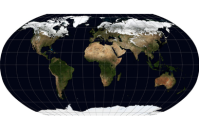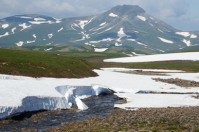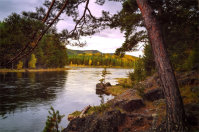Biogeography
Here we will investigate biomes and find out how the fauna of continents differs from each other, and why. And of course, we will learn how to navigate geographic maps OK - by the end, diligent students will do it with closed eyes.
-
Platform: PC, Windows
-
Authorization (the "Login" button in the upper left corner) allows you to monitor your progress.
Сurriculum
1. Maps, Ranges and Biomes
In this lesson, we will understand why zoogeography is needed, we will begin to slowly navigate the continents and large islands, and find out why all geographical maps lie.
In this lesson, we will understand why zoogeography is needed, we will begin to slowly navigate the continents and large islands, and find out why all geographical maps lie.
2. Temperate Broadleaf and Mixed Forest
If the trees are dropping their leaves outside your window, that's great. Since it will not be necessary to jump to pick a leaf and determine the trees from which it fell. Since it is the deciduous trees of the temperate zone, everything connected with them is the main topic of this lesson.
If the trees are dropping their leaves outside your window, that's great. Since it will not be necessary to jump to pick a leaf and determine the trees from which it fell. Since it is the deciduous trees of the temperate zone, everything connected with them is the main topic of this lesson.
It would seem that a city, especially a garbage dump, is not the best place to live. "Jungle" - stone, the air is gassed, people and cars are everywhere. Indeed, who would like to live here? Nevertheless, creatures are lining up for the chance. And now we will know who they are.
4. Equator Quest
Winter Is Coming.
I wish to drop everything and leave this darkness for where the eternal summer is!
But there is such a place - this is the equator. Immediately go there, enjoy, relax, sunbathe and swim, eat juicy tropical fruits, and mingle with friendly natives!
Wait ... is there a catch? ...
5. Kingdoms of Eternal Winter
We have an interesting planet. Everything is on it. There are places where eternal summer reigns. And there are those where eternal winter reigns! This is where we will go.
Winter Is Coming.
I wish to drop everything and leave this darkness for where the eternal summer is!
But there is such a place - this is the equator. Immediately go there, enjoy, relax, sunbathe and swim, eat juicy tropical fruits, and mingle with friendly natives!
Wait ... is there a catch? ...
5. Kingdoms of Eternal Winter
We have an interesting planet. Everything is on it. There are places where eternal summer reigns. And there are those where eternal winter reigns! This is where we will go.
6. Tundra
The place is inhospitable, windy, marshy, and permafrost reigns here. But even here, life is in full swing, especially in the summer, in the form of midges and mosquitoes. Well, a person can survive if they know how.
7. Taiga
Taiga is a huge area covered with coniferous forests. Who lives in them and what secrets they keep - now we will find out everything.
Taiga is a huge area covered with coniferous forests. Who lives in them and what secrets they keep - now we will find out everything.
8. Steppe
In a steppe, there are no trees. Summers are hot and dry, winters are cold and snowless. It's so hot in summer that the asphalt melts and flows along with the markings.
Well, do you want to take a closer look at this place? If yes, let's begin.
9. Subtropical Forest
This is possibly the most favorable place on planet Earth. It's not too cold in winter, not too hot in summer, and food and water are enough. If you suddenly get lost here, consider yourself lucky! Who are the lucky ones who were fortunate to be born and live here? Let's take a closer look at them.
This is possibly the most favorable place on planet Earth. It's not too cold in winter, not too hot in summer, and food and water are enough. If you suddenly get lost here, consider yourself lucky! Who are the lucky ones who were fortunate to be born and live here? Let's take a closer look at them.
10. Tropical Forest
Tropics are places where the Sun can be directly overhead during the day. And where there is a lot of Sun, there is a lot of heat. So it's also the warmest place on Earth. Therefore, there is plenty of space for the forests. They grow huge, in several tiers, closing the foliage so tightly that it is always dusk, and the grass does not grow under the forest canopy. But we will still look there.
11. Savanna
Savanna is an area in the subequatorial zone, covered with grass and sparsely scattered trees and shrubs.
If the savannah had more moisture, it could turn into a subtropical forest. But the dryness of the dry season does not allow it.
It would be a steppe if the savanna were located further north, in a temperate climate. But the savanna is located where it is, and there is as much moisture in it as there is.
So savanna is a savanna, and those who like everything live in it. Who! Press start and find out.
12. Desert
At the word "desert", hot cave dunes immediately come to mind, stretching to the horizon under the scorching sun.
And more often than not, it is. Usually, a desert is a plain on which, if something grows, then very little. But sand is not required there. The desert can be rocky, clayey, or even covered in salt. Also, the desert is not necessarily hot. The snow-white salt plain covered with snow is also a desert! The desert can be very different, but what never changes is that it is dry, like anywhere else. If it snows, then lightly sprinkle the dunes. And if it rains, then without even wetting the sand. And local plants can get moisture from anywhere, even from a drop of morning dew.
Let's take a closer look at this place.
13. Mountain Biomes
Imagine Africa.
Now, imagine a tundra.
Now, imagine the tundra in Africa. Not very easy? Nevertheless, it is there. The fact is that in Africa, there is a relatively high mountain, Kilimanjaro. And like any other mountain, it knows how to do the trick called "altitudinal zonation." The higher you go up the mountain, the colder it gets at the foot of Kilimanjaro - the tropics. Above, they are replaced first by mixed, then mountainous forest, similar to a taiga. Alpine tundra lies even higher. There is a belt of eternal snow at the very top of the mountain. It is almost an arctic desert.
So if you want to see all the natural zones at once, but you're too lazy to walk far, then it is enough to climb the mountain and go down, and as if you have been on a round-the-world trip.
Now, imagine a tundra.
Now, imagine the tundra in Africa. Not very easy? Nevertheless, it is there. The fact is that in Africa, there is a relatively high mountain, Kilimanjaro. And like any other mountain, it knows how to do the trick called "altitudinal zonation." The higher you go up the mountain, the colder it gets at the foot of Kilimanjaro - the tropics. Above, they are replaced first by mixed, then mountainous forest, similar to a taiga. Alpine tundra lies even higher. There is a belt of eternal snow at the very top of the mountain. It is almost an arctic desert.
So if you want to see all the natural zones at once, but you're too lazy to walk far, then it is enough to climb the mountain and go down, and as if you have been on a round-the-world trip.
14. Ocean
Today, we will try to embrace the immensity and get to know all the natural zones of the ocean at once. Unfortunately, this is not so difficult: we know about the oceans almost worse than, say, about Mars or Venus. Throughout history, mankind has managed to explore only 2–5% of the ocean.
15. Littoral
The littoral is a strange place between land and water. It does not have a clear border, it is here and there. But despite this, the littoral is very much loved by various living creatures you won't find anywhere else.
The littoral is a strange place between land and water. It does not have a clear border, it is here and there. But despite this, the littoral is very much loved by various living creatures you won't find anywhere else.
16. Wetland
"Gradually, as we move deeper along the path, the tussocks under our feet become not just soft, as before, but semi-liquid. We step as if onto something solid, but the foot sinks and it becomes frightening: is the foot not completely disappearing into an abyss? We encounter some twisting tussocks, and we have to choose a place to put our foot. And then it goes so that you step, and suddenly, as in the stomach, it gurgles under your foot and runs somewhere... The ground underfoot has become like a hammock, suspended over a murky abyss. On this moving ground, on a thin layer of intertwined roots and plant stems, stand rare, small, gnarled, and moldy little fir trees." This is how the writer Mikhail Prishvin saw the swamp. Not a particularly attractive place. But since you've decided to go there, let's prepare properly! Just in case.








